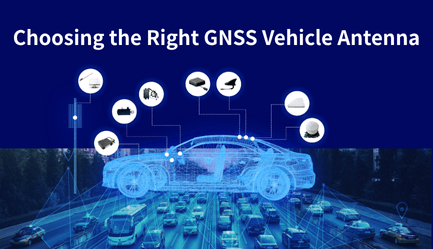

Global Navigation Satellite System (GNSS) vehicle antennas are the backbone of modern positioning and navigation. They are crucial in autonomous driving, precision agriculture, unmanned aerial vehicles (UAVs), and low-speed unmanned delivery vehicles. The antenna you choose will directly impact positioning accuracy, signal stability, and overall system performance.
But not all GNSS vehicle antennas are created equal. Some features are must-haves for high-precision applications, while others are supportive but still important for long-term reliability. This guide highlights the top features you should prioritize, while also pointing out additional factors that can enhance performance.
If there is one feature that stands above the rest, it is multi-constellation and multi-band support.
Why it matters: Access to GPS, GLONASS, Galileo, BeiDou, QZSS, and SBAS significantly improves positioning availability and reliability. Multiple frequency bands (such as L1, L2, L5) allow for correction of atmospheric errors and enable centimeter-level accuracy with RTK technology.
Without it: Single-band or single-constellation antennas limit coverage and accuracy, especially in urban environments or under foliage.
In short: A vehicle antenna that cannot handle multiple constellations and bands will not meet the demands of autonomous vehicles, drones, or precision farming.
The phase center is the theoretical point from which the antenna receives signals. If this point shifts depending on angle or environment, positioning accuracy suffers.
Key takeaway: Look for antennas with low phase center variation (PCV). This ensures reliable, repeatable results even in dynamic conditions like a moving car or drone.
Applications where it is critical: High-precision surveying, autonomous navigation, and mapping systems.
This is one of those technical features that doesn't make headlines but separates professional-grade antennas from basic consumer models.
Many satellites appear close to the horizon rather than directly overhead. A high-quality antenna must be able to capture these low-elevation signals without distortion.
High gain means stronger reception, especially when signals are weak.
Wide beam width ensures coverage across the sky, including near-horizon satellites.
This is particularly important in urban canyons, forested fields, or mountainous terrain, where obstructions reduce visibility.
Vehicles operate in noisy environments filled with radio frequency interference from communication systems, electronics, and even nearby transmitters.
What to look for: Antennas with strong low-noise amplifiers (LNAs), out-of-band filtering, and multipath suppression.
Multipath rejection is equally important, as reflected signals can introduce major errors.
For autonomous cars in cities or drones near communication towers, this feature is absolutely non-negotiable.
GNSS antennas used in vehicles, drones, or agriculture machinery face constant vibration, shock, dust, rain, and temperature swings.
Look for IP67 or IP69K protection ratings, wide operating temperature ranges, and shock/vibration resistance.
A rugged housing not only protects the antenna but also ensures long-term stability.
Durability is often underestimated until a cheap antenna fails in the field. For farmers using GNSS tractors or logistics companies running unmanned delivery fleets, ruggedness is as important as accuracy.
While size may not matter as much for large vehicles, it is a deal-breaker for UAVs and drones.
Lightweight and compact designs reduce drag and improve efficiency.
Flexible mounting options (screw, magnetic, or embedded) simplify integration across platforms.
For low-speed delivery vehicles navigating urban streets, a low-profile antenna also reduces the risk of accidental damage.
Though not as critical as accuracy or ruggedness, power efficiency and connector design can make or break integration.
Low power draw is important for UAVs and battery-powered delivery robots.
Wide voltage range and high-quality connectors (SMA, TNC, FAKRA) ensure stable performance and compatibility.
These features won't directly improve accuracy, but they keep the system reliable and easy to maintain.
GNSS vehicle antennas often operate outdoors 24/7. Exposure to UV radiation, humidity, and even salt spray can degrade performance over time.
Prioritize antennas with corrosion-resistant materials and weatherproof seals.
This ensures the antenna delivers consistent results over years of operation.
While it may seem secondary, long-term stability is essential for commercial deployments.

When evaluating suppliers, one company that consistently stands out is Harxon. Known for its expertise in high-precision GNSS antenna solutions, Harxon designs antennas tailored for demanding applications such as autonomous vehicles, UAVs, precision agriculture, and unmanned delivery systems.
Multi-band, multi-constellation support: Harxon antennas track GPS, GLONASS, Galileo, BeiDou, QZSS, and SBAS, with options for L-Band corrections.
Phase center stability: Their designs ensure minimal PCV, delivering centimeter-level precision.
Rugged and durable: With IP67/IP69K ratings, wide temperature ranges, and shock resistance, Harxon antennas are built for the field.
Compact and versatile: Models like the HX-VR401A and HX-CVX608A are lightweight yet robust, ideal for drones and vehicle integration.
Anti-interference design: Advanced filtering and LNAs provide reliable performance even in challenging electromagnetic environments.
Whether you are building a self-driving car system, deploying drones for surveying, or enhancing precision agriculture machinery, we offer antennas that meet all the essential and supportive features outlined above.
Choosing the right GNSS vehicle antenna means focusing on the features that truly matter:
Multi-constellation and multi-band support
Stable phase center performance
High gain and reliable low-elevation tracking
Strong anti-interference and multipath rejection
Durability and rugged housing
Supporting features like size, mounting flexibility, power efficiency, and environmental resistance further ensure smooth integration and long-term reliability.
For those who want proven performance in autonomous driving, UAVs, precision farming, and unmanned delivery vehicles, Harxon's GNSS vehicle antennas are an excellent choice. They combine advanced engineering with rugged designs, ensuring both accuracy and durability in real-world conditions.